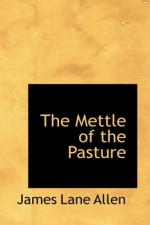IX
The court-house clock in the centre of the town clanged the hour of ten—hammered it out lavishly and cheerily as a lusty blacksmith strikes with prodigal arm his customary anvil. Another clock in a dignified church tower also struck ten, but with far greater solemnity, as though reminding the town clock that time is not to be measured out to man as a mere matter of business, but intoned savingly and warningly as the chief commodity of salvation. Then another clock: in a more attenuated cobwebbed steeple also struck ten, reaffirming the gloomy view of its resounding brother and insisting that the town clock had treated the subject with sinful levity.
Nevertheless the town clock seemed to have the best of the argument on this particular day; for the sun was shining, cool, breezes were blowing, and the streets were thronged with people intent on making bargains. Possibly the most appalling idea in most men’s notions of eternity is the dread that there will be no more bargaining there.
A bird’s-eye view of the little town as it lay outspread on its high fertile plateau, surrounded by green woods and waving fields, would have revealed near one edge of it a large verdurous spot which looked like an overrun oasis. This oasis was enclosed by a high fence on the inside of which ran a hedge of lilacs, privet, and osage orange. Somewhere in it was an old one-story manor house of rambling ells and verandas. Elsewhere was a little summer-house, rose-covered; still elsewhere an arbor vine-hung; at various other places secluded nooks with seats, where the bushes could hide you and not hear you—a virtue quite above anything human. Marguerite lived in this labyrinth.
As the dissenting clocks finished striking, had you been standing outside the fence near a little side gate used by grocers’ and bakers’ carts, you might have seen Marguerite herself. There came a soft push against the gate from within; and as it swung part of the way open, you might have observed that the push was delivered by the toe of a little foot. A second push sent it still farther. Then there was a pause and then it flew open and stayed open. At first there appeared what looked like an inverted snowy flagstaff but turned out to be a long, closed white parasol; then Marguerite herself appeared, bending her head low under the privet leaves and holding her skirts close in, so that they might not be touched by the whitewash on each edge. Once outside, she straightened herself up with the lithe grace of a young willow, released her skirts, and balancing herself on the point of her parasol, closed the gate with her toe: she was too dainty to touch it.
The sun shone hot and Marguerite quickly raised her parasol. It made you think of some silken white myriad-fluted mushroom of the dark May woods; and Marguerite did not so much seem to have come out of the house as out of the garden—to have slept there on its green moss with the new moon on her eyelids—indeed to have been born there, in some wise compounded of violets and hyacinths; and as the finishing touch to have had squeezed into her nature a few drops of wildwood spritishness.




